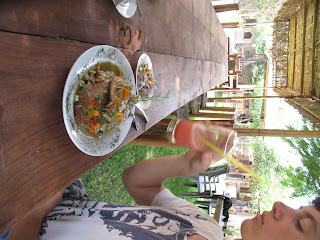And lots of time with humans.
My set-up is particularly good that way.
Even when my most-favorite-human goes to work in the morning (after I've taken her for a walk and we've had breakfast); I get to hang with second-most-favorite human. She's great, except with a vacuum cleaner.
Still, it's good to get out of the city from time to time.
So, I took my humans to Lunahuana recently. We had a leash-free weekend. Let me tell you. That was a-okay.
We stayed in a hotel that had a great setup. A big garden. Lots of room to run. Good dog pals. Just the usual territory sniff-bark business, and then we got down to the business of being a pack.
These stairs go up to the hotel Refugio de Santiago. Come on up. It's great.
Here's part of the large garden. It's full of fruit trees, herbs, and native plants. The owner will tell you all about them, and adds them to the delicious meals he prepares in the restaurant.
Mota was one of the local dogs. She was a bit big around the middle for my taste, but some people go for that. I had to keep an eye on her, because she kept trying to take over my most favorite human.
Pretty well set up for chill-axing.
Even the cookware is happy at hotel Refugio de Santiago
Breakfast of champions - fresh mango juice and eggs mixed with local greens.
Lunch - smoked trout and fresh veggies from the garden.
Fresh strawberry juice and duck.
My humans thought the view was cool.
We took a walk down to the river.
Here we are by a church that was demolished in a flood. And they wonder why I don't like water.
My humans like the water.
Lots of room to play ball in the gardens of the Refugio
So they had this rug. Not soft and fuzzy like the ones at home.
My humans like to wear hats.
These smaller versions of humans were our guides on a long walk. Lots of great stinky stuff.
My man human.
Humans seem to make a big deal out of the end of the day.
Day 2, we took a hike through some Inca ruins.
The men humans were really into walking in this rocky place. Pretty hot and not much to smell, if you ask me.

























































